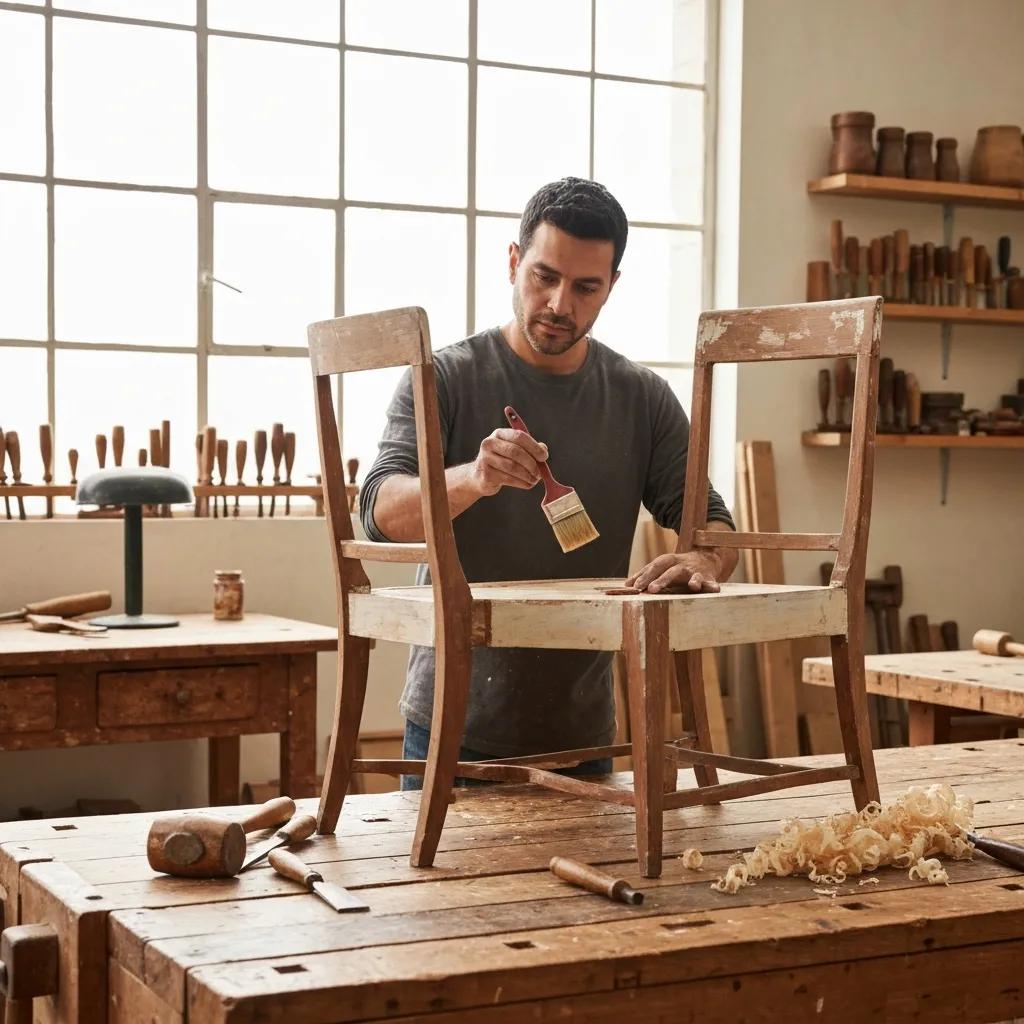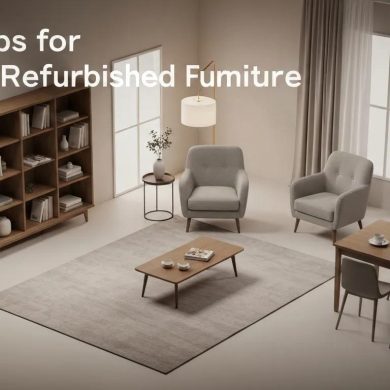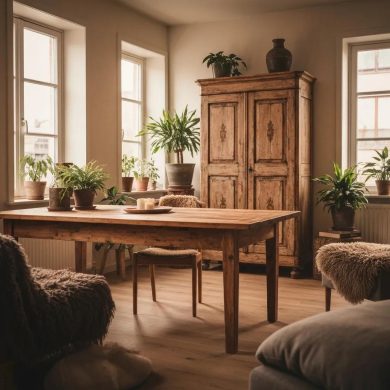Discover Local Refurbished Furniture Shops Near You
Discover Refurbished Furniture Near You — Sustainable, Bespoke and Built to Last
Refurbished furniture means pre-owned wooden pieces that have been carefully inspected, repaired and refinished so they’re structurally sound and attractive again. This guide explains how refurbished wooden furniture combines sustainability, skilled workmanship and one-of-a-kind character, and it shows practical ways to find local refurbished furniture shops — with specific tips for Harrogate. Many homeowners want to cut waste, avoid mass-produced pieces and choose items that can be mended or tailored; refurbished furniture answers that by offering solid-wood construction and sensible restorative techniques that often outlast cheaper new alternatives. Read on to learn the environmental and quality benefits of refurbished wooden furniture, how to assess local showrooms and restoration workshops, what commissioning a bespoke kitchen or piece involves, how to buy restored items online with nationwide delivery, and the technical steps restorers use to ensure longevity.
Keywords such as local refurbished furniture shops, refurbished furniture near me, refurbished wooden furniture, bespoke refurbished furniture and refurbished kitchens are woven throughout to help you find sustainable solutions and make informed purchases as of 11/2025.
Why Choose Refurbished Furniture Near Me? Benefits of Sustainable, Eco-Friendly Wooden Pieces

Refurbished wooden furniture offers a practical route to a more sustainable home without sacrificing quality. By reusing durable timber and preserving traditional joinery, refurbished pieces divert material from landfill, cut embodied carbon versus new production and often keep thicker, better-built timber in use longer than modern mass-produced equivalents. The result is a smaller environmental footprint, strong long-term value and a look that brings personality to a room. Below are the main benefits presented clearly to help you compare options quickly.
Refurbished wooden furniture delivers several key benefits:
- Environmental savings: Reuse reduces waste and conserves resources compared with producing new timber.
- Quality & longevity: Solid wood frames and traditional joinery usually mean a longer usable life.
- Unique character: Patina, reclaimed materials and bespoke finishes create singular pieces with history.
- Cost efficiency: Restored items can deliver similar utility for a lower lifecycle cost than cheap new furniture.
These advantages make refurbished options attractive to homeowners and designers focused on sustainability, and they lead naturally into the more detailed environmental and durability considerations below.
Intro to comparison table: The table that follows compares common refurbished wooden pieces against key lifecycle and environmental factors to help clarify the trade-offs when choosing refurbished over new.
| Item Type | Lifecycle Advantage | Environmental Impact |
|---|---|---|
| Refurbished wooden dining table | Preserved solid wood and joinery; straightforward to repair | Lower embodied carbon than manufacturing new equivalents |
| Reclaimed-wood wardrobe | Distinctive patina and stable timber; long-term serviceability | Conserves old-growth character and reduces demand for new timber |
| Refurbished bespoke kitchen | Restored cabinets and updated hardware; adaptable to the space | Extends the life of existing units and cuts landfill waste |
This comparison highlights how refurbished pieces improve material efficiency and durability, reinforcing why local refurbishment specialists matter for transparent sourcing and high-quality restoration work.
For shoppers who value verifiable craftsmanship and sustainable practice, Sustainable Refurbished Furniture By HDS is a local example of these benefits: hand-finished restoration, bespoke commissions and considered finishes. Their focus on careful refurbishment — from hand-painted to spray finishes — and on bespoke wooden kitchens shows how local expertise can pair sustainability with design flexibility. Mentioning this local capability helps you consider a nearby showroom or workshop visit to inspect workmanship and discuss custom options in person.
What Are the Environmental Advantages of Buying Refurbished Furniture?
Choosing refurbished furniture reduces the need for new material extraction and manufacturing by keeping existing timber in use longer, which lowers demand for fresh timber and the energy used in milling, assembly and transport. Reuse prevents usable items from entering landfill and cuts the embodied carbon associated with equivalent new pieces. Practically, buying refurbished or reclaimed-wood furniture supports a circular economy where repair and reuse replace one‑off replacement. Understanding these mechanisms helps buyers make choices that align with lower-carbon living and sustainable interior design.
Reclaimed Wood in Furniture: Sustainability and Life Cycle Analysis
Abstract: This paper is the second part of a study exploring the potential to use reclaimed wood as a raw material in furniture manufacture instead of new timber. The authors highlight environmental costs using Life Cycle Analysis, comparing two versions of the same product — one made from new materials and one from reclaimed materials — to identify the major sustainability issues across the product life cycle and end-of-life scenarios. The findings inform more forward-thinking product design in the furniture industry. Key words: Furniture, sustainability, reclaimed wood, life cycle analysis.
Studies regarding the use of reclaimed wood in the manufacture of modern furniture – Part II, I BADIU, 2015
How Does Refurbished Wooden Furniture Offer Quality and Durability?
Most refurbished wooden furniture begins life as well-made construction — solid timber frames, dovetailed drawers and thicker boards — which provides a strong basis for long-term use. Professional restorers address structural faults with joinery reinforcement, wood consolidation and selective replacement of damaged parts, preserving the original build while increasing longevity. Surface work — cleaning, sanding, priming and applying robust finishes — restores appearance and adds protection against moisture and wear. Spotting these quality indicators will help you evaluate listings and showroom pieces for repairability and long-term value.
Knowing what to look for in quality and durability points you to shops and restorers that prioritise both structure and the right finishing techniques; the next sections explain how to find them locally.
Where to Find Trusted Local Refurbished Furniture Shops in Harrogate and Nearby Areas?
Finding a reliable local refurbished furniture shop combines online research with a hands-on visit to judge workmanship and sourcing. Look for businesses that show before-and-after galleries, explain restoration steps and display bespoke commission examples — these are signs of skilled craft and transparency. Visiting a showroom or warehouse lets you check solid-wood construction, feel sample finishes and talk restoration methods with the people who do the work. The checklist below helps you vet local stores and prepares you for a productive visit — especially when assessing refurbished wooden furniture and bespoke kitchens.
Use this checklist when vetting local refurbished furniture shops:
- Review restoration galleries: Seek clear before-and-after photos that show structural repairs and finishing quality.
- Ask about materials and finishes: Find out whether reclaimed wood is used and whether finishes are hand-painted, spray-applied or oil-based.
- Inspect construction details: Check joints, drawer slides and internal carcass work to confirm long-term durability.
This approach improves purchase confidence and leads into what to expect when visiting Harrogate showrooms and workshops in person.
What Makes Sustainable Refurbished Furniture By HDS Unique in Harrogate?
Sustainable Refurbished Furniture By HDS specialises in bringing pre-owned wooden furniture back to life, focusing on craft, considered finishes (hand-painting and spray techniques) and bespoke refurbished kitchens and pieces.
Their Harrogate shop and warehouse give customers the chance to inspect restored pieces, compare finish samples and talk through bespoke commissions face-to-face, which builds trust and transparency. Their emphasis on upcycling existing timber and prioritising repair aligns with eco-conscious interiors while offering tailored design options for homeowners. For anyone after locally produced bespoke work with nationwide delivery, this specialist is a practical choice — though it’s always sensible to compare a few providers.
Below is a practical visit plan to help you prepare for a Harrogate showroom or warehouse appointment.
How to Visit and Explore the Harrogate Furniture Shop and Warehouse?
When you plan a showroom or warehouse visit, bring measurements, photos of your space and a short brief describing how you’ll use the piece so restorers can advise on structure and finishes. Book an appointment if available so staff can give focused time to inspect pieces and discuss bespoke commissions; in-person conversations often reveal timber options and finish samples that photos cannot. During your visit, check joinery, test drawers and doors, and ask the team to explain the restoration steps taken on pieces you like. Discuss delivery and any installation support for kitchens or large items, and request finish samples to compare hand-painted and spray-finished looks.
Preparing these details makes consultations more productive and helps smooth the path to commissioning or buying a restored item.
How Can You Customise Bespoke Refurbished Furniture and Kitchens?
Customising refurbished furniture and kitchens usually follows a clear commissioning path: an initial consultation and brief, design and material choices with finish samples, the restoration and finishing work itself, and a final sign-off followed by delivery and installation. This sequence ensures the original structure is assessed and adapted to your space and style while allowing choices in reclaimed wood, hardware and finish technique. The list below outlines the common options you can expect when commissioning bespoke restored pieces.
Common customisation options include:
- Finish choices: Hand-painted colours, spray-finished surfaces or natural oils to suit different looks and protection levels.
- Wood selection: Reclaimed planks, stable hardwoods or patched solid timber to match the desired character and performance.
- Hardware & layout: Custom handles, soft-close fittings and layout changes for kitchens or storage to suit modern use.
These choices guide practical decisions during commissioning and are summarised in the quick-reference table below.
| Customisation Aspect | Options | Typical Outcome |
|---|---|---|
| Finish | Hand-painted / Spray-finish / Natural oil | Aesthetic control versus consistency and long-term durability |
| Wood Source | Reclaimed wood / Solid timber | Distinctive patina with stable long-term performance |
| Hardware | Traditional brass / Modern soft-close | Functionality matched to the design intent |
Sustainable Refurbished Furniture By HDS accepts bespoke commissions for refurbished furniture and kitchens, and offers nationwide delivery so clients outside Harrogate can commission restored pieces tailored to their homes. Their process — discussing design, showing finish samples and coordinating restoration — follows the step-by-step commissioning workflow above, delivering custom outcomes while keeping sustainability in focus.
What Is the Process for Ordering Custom Refurbished Wooden Furniture?
Ordering custom refurbished furniture starts with a brief and consultation to confirm dimensions, intended use and style. From there you’ll receive design proposals and finish samples for approval. A deposit typically secures the commission and schedules the restoration, during which structural repairs, wood preparation and finishing work proceed under experienced supervision. Final sign-off includes a client inspection and arranging delivery or installation; lead times vary with complexity and chosen finishes. Clear communication at every stage reduces surprises and helps ensure the restored piece meets both function and appearance expectations.
This clear process helps clients set realistic timelines and budgets when commissioning bespoke work.
What Are the Benefits of Hand-Painted and Spray-Finished Bespoke Pieces?
Hand-painted finishes give depth, visible brushwork and fine control over colour and distressing, making them well suited to statement pieces where surface texture matters. Spray-finished surfaces offer uniform coverage, greater abrasion resistance and a smoother look, which is useful for larger surfaces or pieces that see heavy daily use. Costs and maintenance differ: hand-painted finishes may need more careful touch-ups to preserve their character, while spray finishes typically clean more easily and resist wear. Your choice depends on the desired look, how the piece will be used and whether you want a showpiece or a durable everyday item.
Understanding these differences helps buyers request the right finish in the design phase and plan for ongoing care.
How to Shop Refurbished Furniture Online: Browse Unique Vintage and Sustainable Collections
Shopping for refurbished furniture online takes careful reading of product descriptions to confirm materials, condition, restoration methods and provenance where available. Quality listings include multiple clear photos, honest condition notes and a specification of materials such as reclaimed wood or solid frames — this transparency supports confident purchases when you can’t inspect items in person. Ask sellers specific questions about measurements, how repairs were carried out and which finishes were used; these queries reveal whether a piece was professionally restored or only superficially refreshed. The list below summarises what to look for and how to compare sellers effectively.
When evaluating online listings, focus on these aspects:
- Detailed descriptions: Look for material, finish and restoration-process information, not vague condition notes.
- High-quality photos: Multiple angles and close-ups of joinery and finishes reveal construction quality.
- Seller policies: Clear delivery, insurance and return terms reduce the risk of buying large items remotely.
After choosing items, delivery planning becomes important for timing and protection during transit — the table below summarises typical options.
| Item Size | Delivery Type | Typical Coverage |
|---|---|---|
| Small item | Parcel / Local courier | Tracked delivery, limited assembly |
| Medium furniture | Dedicated courier / Crated shipping | Basic delivery with possible assembly required |
| Large items / kitchens | White-glove delivery | Room placement, unpacking and optional installation — recommended for fitted kitchens |
This comparison clarifies how delivery options expand with item size and helps buyers plan for insurance, assembly and installation when buying refurbished furniture online.
Once you’ve selected items and planned delivery, Sustainable Refurbished Furniture By HDS provides a straightforward route to order restored pieces and arrange nationwide delivery. Customers can enquire about specific listings, request bespoke commissions and discuss delivery options to ensure safe transit and installation — practical for buyers who aren’t local to Harrogate.
What Types of Refurbished Wooden Furniture Are Available Online?
Typical online refurbished collections include dining tables, chairs, cabinets, wardrobes, chests of drawers and bespoke kitchen units, each restored to functional standards with attention to joinery and finishes. Condition labels — such as structurally restored, surface refinished or reclaimed-material construction — indicate restoration level and help set expectations for wear and maintenance. When browsing, look for construction details (drawer bottoms, dovetails and back panels) and ask for extra photos if needed. Recognising these categories and condition cues helps you prioritise items that fit your use-case and longevity needs.
These checks lead naturally into planning delivery and what to expect when receiving large refurbished pieces.
How Does Nationwide Delivery Work for Refurbished Furniture Orders?
Nationwide delivery usually offers tiered services: standard courier for small items, dedicated crated shipping for medium pieces and white-glove services for large or delicate items that include in-home placement and removal of packaging. Lead times depend on restoration schedules, distance and chosen service level; expedited options may be available for an extra fee. Transit insurance and delivery condition confirmations protect buyers against damage, while local installers or fitters handle complex kitchen installations. Preparing a receiving plan — clear access, measured doorways and a designated placement spot — reduces risk and helps deliveries run smoothly for large refurbished pieces.
This logistical clarity supports buyers arranging long-distance purchases or bespoke commissions with nationwide delivery.
What Is the Refurbishment Process Behind Quality Wooden Furniture?
A quality refurbishment begins with a full assessment to identify structural issues, followed by targeted repairs such as joint reinforcement, veneer consolidation or component replacement. Surface preparation — cleaning, sanding, filling and priming — creates a stable base for finishes, while finish selection (hand-paint, spray, oils or lacquers) balances look and durability. Quality control includes testing drawers and doors, moisture checks and final surface protection to extend service life. These technical steps combine original construction strengths with modern protective finishes to produce restored furniture that is both attractive and durable.
Environmental Impact of Reclaimed Lumber and Wood Flooring
This study quantifies the benefits of reclaiming wood compared with using virgin alternatives. It measures the environmental impact of reclaiming framing lumber and wood flooring against new timber by using life-cycle inventory analysis, showing how reclaimed materials reduce embodied impacts versus virgin sources.
Using reclaimed lumber and wood flooring in construction: measuring environmental impact using life-cycle inventory analysis, RD Bergman, 2010
A concise, step-by-step overview below gives a quick reference for the refurbishment workflow.
- Assessment: Inspect structure, materials and damage to determine required repairs.
- Repair & stabilise: Reinforce joints, replace worn parts and consolidate degraded wood.
- Surface preparation: Clean, sand, fill and prime to create a stable substrate.
- Finish application: Apply hand-paint, spray finishes or protective oils as chosen.
- Quality check & delivery: Test functions, protect finishes and prepare for safe shipment or installation.
How Are Old Furniture Pieces Restored to Ensure Longevity and Style?
Restoration balances structural repair with sensitive aesthetic renewal: joinery is reinforced or replaced using traditional techniques to preserve load-bearing capacity, while surface treatments restore visual appeal. Wood consolidation and careful replacement of compromised elements retain as much original material and patina as possible. Finish choice and application follow material requirements, with protective coatings selected to resist wear while matching the intended look. Together, these structural and surface interventions make pieces that are both long-lasting and visually coherent for everyday modern use.
These restoration principles explain why reclaimed and refurbished furniture remains a practical, stylish choice for sustainable living.
Why Is Using Reclaimed Wood Important for Sustainable Furniture?
Reclaimed wood reduces pressure on forests by repurposing existing timber, often preserving old-growth characteristics and grain patterns that are rare in new material. Using reclaimed wood supports circular-material practices and cuts embodied emissions by avoiding fresh processing and long supply chains. Aesthetically, reclaimed timber brings a rich patina and a story to a room, and traceable sourcing helps buyers make ethically informed choices. Choosing reclaimed wood in refurbishment aligns design with measurable sustainability goals and supports a market for repair and reuse.
This thinking ties into the broader lifestyle benefits of adding refurbished furniture to greener homes, which we cover next.
How Does Sustainable Living Benefit from Upcycled and Refurbished Furniture?
Upcycled and refurbished furniture reduces household waste and lowers the carbon footprint of furnishing a home, making it a practical element of a sustainable lifestyle. Choosing restored pieces encourages longer product lifecycles and reduces the frequency of full replacements, shrinking the cumulative environmental cost of new manufacturing. Combining refurbished items with new pieces keeps interiors versatile while conserving resources and promoting repairability as a standard household practice. The list below gives actionable tips for homeowners who want greener interiors using refurbished furniture.
Practical ways to incorporate refurbished furniture into a sustainable home:
- Mix and match: Pair refurbished statement pieces with modern items to balance style and cost.
- Maintain & protect: Use suitable cleaners and occasional touch-ups to extend lifespan.
- Choose durable finishes: Pick finishes that suit the intended use — hardwearing spray finishes for high-traffic surfaces, oils for lower-touch furniture.
These everyday practices make sustainable furnishing achievable and attractive, delivering long-term savings and real environmental benefits.
What Role Does Refurbished Furniture Play in Reducing Waste and Carbon Footprint?
Refurbished furniture reduces waste by keeping usable materials out of disposal streams and extending the active life of timber and components, which lowers cumulative resource extraction over time. A repair-first approach reduces the need for new production, cutting embodied emissions from manufacturing, transport and raw material processing. By choosing restored or reclaimed-wood items, consumers support a market that values longevity and repairability, shifting behaviour toward circular principles and away from disposable furniture models.
Understanding this role explains why local refurbishment networks and skilled restorers are vital to a functioning circular furniture economy.
How Can Choosing Refurbished Furniture Support a Greener Home?
Selecting refurbished pieces supports a greener home by prioritising durable materials, allowing tailored repair strategies and reducing the need for wholesale replacement. Styling refurbished items with contemporary pieces can refresh interiors without large purchases, while maintenance practices such as periodic oiling or careful cleaning preserve finishes and performance. Prioritising strong joinery and repairable construction makes future repairs easier and encourages a culture of upkeep, which lowers lifetime environmental impact and supports sustainable living goals.
These practical steps help homeowners turn environmental intent into durable, beautiful interiors kept alive through repair and reuse.
Frequently Asked Questions
What should I look for when evaluating the quality of refurbished furniture?
Focus on construction, materials and the restoration process. Look for solid wood frames, traditional joinery and neat craftsmanship. Check for evidence of professional restoration such as reinforced joints, smooth finishes and clean repairs. Ask which finishes were used, since that affects durability and upkeep. A trustworthy seller will be transparent about methods and materials so you can judge the piece with confidence.
How can I ensure the sustainability of the refurbished furniture I purchase?
Choose suppliers who prioritise eco-friendly practices — reclaimed wood, non-toxic finishes and clear sourcing information are good signs. Ask about the restoration steps taken and whether materials are traceable. Certifications, detailed provenance or a clear sustainability statement demonstrate commitment. Also consider the piece’s expected lifespan: items designed for repairability and longevity deliver the greatest environmental benefit.
What are the typical costs associated with commissioning bespoke refurbished furniture?
Costs vary by complexity, materials and craft level. Bespoke refurbished pieces can range from a few hundred to several thousand pounds or dollars depending on scope. Discuss your budget at the initial consultation so expectations align. Remember that bespoke options often offer long-term value through durability and a tailored design that fits your home.
How do I maintain and care for refurbished furniture?
Regular gentle cleaning and occasional touch-ups will keep restored furniture performing well. Use non-abrasive cleaners suited to the finish and avoid harsh chemicals. For wood finishes, periodic oiling or waxing can help protect surfaces from wear and moisture. Keep pieces out of direct sunlight to reduce fading and warping. Following these simple steps will help your refurbished furniture stay beautiful and functional for years.
Can I customise the design of refurbished furniture to fit my home decor?
Yes — many refurbishers offer custom options so pieces fit your style and space. You can usually choose finishes, colours and materials, and request size or layout modifications. During the commissioning process, discuss your preferences with the craftsman who can advise on what’s feasible and durable. Customisation lets you create unique pieces that integrate seamlessly into your home.
What are the benefits of choosing local refurbished furniture shops?
Buying locally lets you inspect items in person and assess quality and workmanship directly. Local shops often understand regional tastes and provide personalised service. Purchasing nearby also reduces transport-related carbon and supports the local economy. Building a relationship with local craftspersons can lead to bespoke commissions and ongoing support for maintenance or future work.
Conclusion
Choosing refurbished wooden furniture supports sustainable practice while adding character and quality to your home. By investing in restored pieces you help reduce waste and preserve valuable resources, all while enjoying craftsmanship that carries a story. Explore local shops to find bespoke options that suit your style and values, and consider nationwide specialists if you’re further afield. Visit our website to view a curated selection of premium refurbished furniture and to discuss commissions that meet your needs.







Add comment